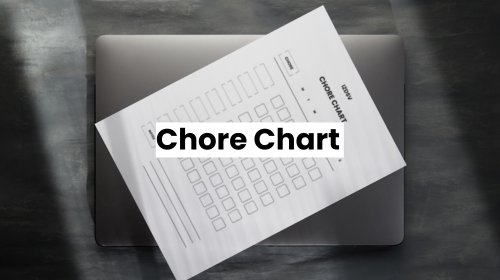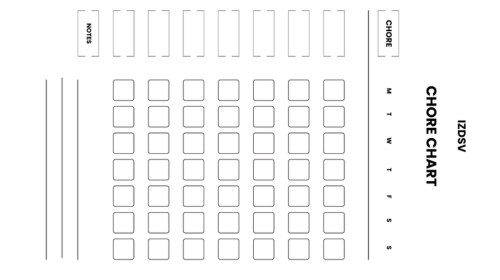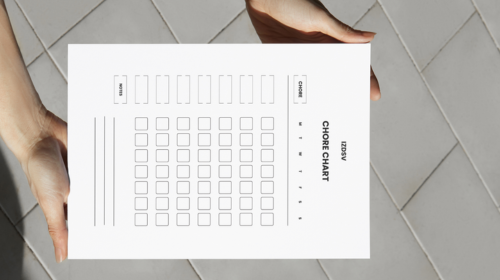What is a Chore App and How Can It Help Families?
A chore app is a digital tool designed to organize, assign, and track household tasks among family members. It serves as a centralized system for managing responsibilities, replacing traditional paper chore charts with interactive, often gamified digital interfaces.
- Creates a clear system for assigning and tracking household responsibilities
- Provides visibility into who is responsible for what tasks and when they’re due
- Reduces parental nagging by transferring responsibility to the app’s notification system
- Offers digital record-keeping of completed chores and contributions
- Helps distribute household work more equitably among family members
- Can be accessed by all family members via smartphones or tablets
- Often includes features for rewards, points, or allowance tracking
Understanding Chore Apps
Chore apps typically feature intuitive interfaces that allow parents to create, assign, and monitor tasks while giving children a clear view of their responsibilities. Modern chore apps range from simple task-tracking tools to comprehensive family management systems with features like digital allowance tracking, rewards systems, and communication tools.
- Most apps allow customizable chore creation with frequency settings (daily, weekly, monthly)
- Task assignments can be personalized for different family members based on age and ability
- Many include visual elements like avatars, progress bars, or virtual stickers
- Some offer photo verification features to confirm task completion
- Premium versions often include allowance tracking and digital banking features
- Many integrate with family calendars or reminder systems
- Apps typically offer both parent and child interfaces with different permission levels
Benefits of Using a Family Chore App
Family chore apps streamline household management while teaching children valuable life skills such as responsibility, time management, and work ethic. They transform the often contentious topic of chores into a more structured, transparent, and sometimes even enjoyable process for the entire family.
- Reduces household tension and arguments about chores
- Creates consistency in expectations and consequences
- Teaches children financial literacy when tied to allowance
- Helps develop time management and personal responsibility skills
- Gives children a sense of contribution to family functioning
- Provides parents with tools to increase responsibilities as children mature gradually
- Creates a system that persists even during busy times or schedule changes
- Often reduces screen time battles by making productive use of devices
- Can help children with executive functioning challenges through visual schedules and reminders
How Chore Apps Motivate Kids
Chore apps leverage principles of behavioral psychology and gamification to transform mundane household tasks into engaging activities that children are more motivated to complete. By incorporating immediate feedback, visual progress tracking, and tangible rewards, these apps tap into children’s natural desire for achievement and recognition.
- Convert chore completion into points, virtual currency, or other trackable metrics
- Offer digital badges, stickers, or trophies as immediate positive reinforcement
- Create friendly competition between siblings through leaderboards or challenges
- Provide visual progress tracking toward goals or rewards
- Connect task completion to real-world rewards like allowance or privileges
- Celebrate streaks and consistency with special recognition
- Some include avatar systems that grow or gain abilities as chores are completed
- Can feature leveling-up systems similar to video games
- Often include customizable reward systems that parents can tailor to their values and parenting style
How to Choose the Best Chore App for Your Family?
Selecting the right chore app requires considering your family’s specific needs, routines, and the ages of your children. The best chore app for your family aligns with your parenting philosophy and technical comfort level while addressing the specific household management challenges you face.
- Assess your primary goals (task management, allowance tracking, behavior modification)
- Consider the ages and number of children who will use the app
- Evaluate your family’s tech proficiency and device availability
- Determine your budget for subscription-based services
- Check compatibility with your existing devices and operating systems
- Read user reviews from families similar to yours
- Test free versions before committing to paid subscriptions
- Consider how the app’s philosophy aligns with your parenting style
Key Features to Look for in a Chore Management App
When evaluating chore apps, certain core functionalities can make the difference between an app that’s quickly abandoned and one that becomes an integral part of your family routine. The most effective chore apps combine user-friendly interfaces with flexible customization options and engaging motivational tools.
- Intuitive interfaces for both parents and children
- Customizable chore creation with adjustable difficulty levels
- Recurring task scheduling options (daily, weekly, monthly)
- Visual task verification methods (photo submission, check-offs)
- Reward systems that align with your values (points, privileges, allowance)
- Multiple user accounts with appropriate permission levels
- Notification systems that don’t require parent involvement
- Calendar integration for scheduling and planning
- Data export options for tracking progress over time
- Offline functionality for homes with limited connectivity
- Age-appropriate design for younger and older children
Comparing Popular Chore Apps: Notion vs. Homey
Notion and Homey represent two different approaches to family chore management, with Notion offering highly customizable templates in a general productivity platform and Homey providing a dedicated, gamified system specifically designed for family chore tracking. Each platform has distinct advantages depending on your family’s needs and technical preferences.
- Notion is a flexible productivity tool that can be customized for chore tracking
- Homey is purpose-built for family chore management with kid-friendly interfaces
- Notion requires more initial setup but offers unlimited customization possibilities
- Homey provides ready-to-use chore lists and age-appropriate task suggestions
- Notion has more robust project management features for complex household systems
- Homey includes built-in reward systems and allowance tracking
- Notion offers extensive integration with other productivity tools
- Homey features more gamification elements like avatars and achievement badges
- Notion may appeal more to tech-savvy families who enjoy building custom systems
- Homey typically has a gentler learning curve for both parents and children
Customizable Options in Chore Apps
The ability to tailor a chore app to your family’s specific needs is crucial for long-term adoption and effectiveness. Modern chore apps offer various customization features that allow you to adapt the system as your children grow and your family’s needs evolve.
- Custom chore creation with personalized instructions and time estimates
- Adjustable difficulty levels and age-appropriate task suggestions
- Flexible reward systems (point values, monetary rewards, privileges)
- Personalized avatars and profile settings for each family member
- Custom categories for different types of household responsibilities
- Adjustable reminder frequency and notification styles
- Seasonal or special occasion chore templates
- Customizable incentive structures (immediate vs. delayed rewards)
- Visual theme options to maintain engagement
- Progression systems that grow with children’s abilities
- Parent approval settings that can be adjusted based on trust and age
How to Organize Household Chores with a Chore Chart?
A chore chart provides visual organization for household responsibilities, making expectations clear and tracking progress simple for all family members. Effective chore charts balance structure with flexibility, accommodating your family’s unique rhythm while ensuring essential tasks don’t fall through the cracks.
- Start by listing all household tasks that need regular attention
- Categorize chores by frequency (daily, weekly, monthly, seasonal)
- Consider categorizing by location (kitchen, bathroom, outdoors) or type (cleaning, maintenance, pet care)
- Match tasks to appropriate family members based on age and ability
- Create a visual system that’s easy to understand at a glance
- Choose between digital or physical formats based on your family’s preferences
- Include space for tracking completion and verification
- Consider using color-coding or symbols for different categories or family members
- Start simple and add complexity gradually as the system becomes routine
- Place the chart in a central location where everyone can see it
- Schedule regular reviews to adjust as family needs change
Creating Effective Chore Lists for Kids
Effective chore lists for children balance age-appropriate responsibilities with clear instructions and reasonable expectations. The most successful chore systems for kids grow with them, gradually increasing independence and complexity as they develop more skills and maturity.
- Match chores to developmental abilities rather than strictly to age
- Break down complex tasks into smaller, manageable steps for younger children
- Include visual instructions or pictures for pre-readers
- Start with self-care tasks (making bed, putting away clothes) before family responsibilities
- Limit the number of daily chores to prevent overwhelm (1-2 for young children, 3-5 for older ones)
- Pair preferred tasks with less desirable ones for balance
- Include a mix of daily habits and weekly responsibilities
- Consider creating “training periods” for new chores before expecting mastery
- Recognize the difference between “child-help” (helping you clean) and “child-solo” tasks
- Ensure tasks have clear completion criteria so children know when they’re finished
- Rotate certain chores to prevent boredom and build diverse skills
Assigning Chores and Managing Cleaning Schedules
Strategic chore assignments and well-designed cleaning schedules transform household management from chaotic to controlled, distributing work fairly while ensuring all necessary tasks are completed. Creating effective chore rotations requires balancing individual capabilities with household requirements while building in accountability mechanisms.
- Consider creating zones of responsibility rather than specific task lists
- Implement rotation systems to ensure everyone learns different household skills
- Factor in school, work, and activity schedules when assigning time-sensitive tasks
- Create “job cards” with detailed instructions for complex or infrequent tasks
- Balance high-effort and low-effort tasks for each family member
- Consider “all hands” cleaning sessions for family bonding and efficiency
- Implement seasonal deep cleaning schedules alongside regular maintenance
- Assign backup responsibilities for when the primary assignees are unavailable
- Create “clean sweep” times when everyone tidies simultaneously for 10-15 minutes
- Consider natural consequences for incomplete tasks rather than punishment
- Recognize different cleanliness standards and negotiate acceptable minimums
Tracking Completed Chores: The Role of Notifications
Tracking completed chores through notifications and verification systems creates accountability while providing satisfying feedback for tasks well done. Strategic notification systems shift responsibility from parents to children while creating a record of contribution that can be tied to privileges or rewards.
- Determine whether physical check-offs or digital confirmations work better for your family
- Consider requiring photo evidence for remote verification of completed tasks
- Establish clear deadlines and notification frequencies that minimize nagging
- Create a verification process that respects growing independence
- Use notifications as reminders rather than first alerts for responsibility
- Consider tiered notification systems that increase in urgency as deadlines approach
- Implement a review process for quality control of completed tasks
- Use completion tracking as positive reinforcement and progress visualization
- Consider weekly review meetings to discuss challenges and successes
- Balance automation with personal accountability
- Use notification data to identify patterns and adjust the system as needed
Can Chore Apps Teach Kids About Money and Responsibility?
Chore apps create powerful connections between work, rewards, and financial literacy that help children develop crucial life skills. These digital tools transform abstract concepts like responsibility and money management into tangible experiences with real-world consequences and benefits.
- Link completed tasks directly to earnings, creating clear work-reward relationships
- Provide visual tracking of earnings and savings progress
- Introduce concepts like saving, spending categories, and delayed gratification
- Offer opportunities to practice decision-making with earned money
- Create natural consequences for incomplete responsibilities
- Build consistent habits around work and reward expectations
- Allow children to experience the satisfaction of earning their own money
- Provide parents with tools to adjust the system as children develop
- Facilitate conversations about money, value, and work ethic
- Help children internalize the concept that contributions have value
- Create frameworks for both immediate and long-term financial goals
How Kids Earn Allowance Through Completed Chores
The connection between chores and allowance creates a foundational understanding of work-based compensation that prepares children for adult financial realities. Modern chore apps transform traditional allowance systems with automated tracking, variable compensation models, and transparent earning histories.
- Establish clear payment rates for different types of tasks
- Differentiate between “citizenship” chores (expected family contributions) and “bonus” chores (additional earning opportunities)
- Create tiered payment structures based on task difficulty or time requirements
- Implement consistent payment schedules (weekly, biweekly) to mirror adult paydays
- Offer bonus opportunities for exceptional work or initiative
- Consider performance-based adjustments for quality and thoroughness
- Track earnings history to discuss patterns and progress
- Create visual savings goals connected to specific earning targets
- Allow children to propose new tasks and negotiate compensation
- Consider implementing “commission” systems rather than fixed allowances
- Provide opportunities to earn through both regular and occasional tasks
Financial Education: Teaching Kids Financial Responsibility
Chore apps extend beyond task management to become platforms for comprehensive financial education, introducing concepts like budgeting, saving, and charitable giving. The digital nature of these tools creates opportunities for parents to guide children through financial decisions with appropriate scaffolding and progressive independence.
- Implement virtual banking features to track earnings, savings, and spending
- Create separate virtual “accounts” for spending, saving, and giving
- Set up automatic percentage allocations to different financial categories
- Establish short and long-term savings goals with visual progress tracking
- Introduce concepts like interest by offering bonuses for maintained savings
- Create opportunities to practice budgeting for specific wants or needs
- Discuss the difference between needs and wants using real examples
- Use the app’s history features to review spending patterns and decisions
- Implement cooling-off periods for larger purchases to discourage impulse buying
- Connect digital tracking to real-world banking through periodic transfers
- Gradually increase financial decision-making autonomy as children demonstrate responsibility
Encouraging Older Kids to Take Responsibility
For adolescents and teens, chore apps can evolve from simple task trackers to comprehensive responsibility management systems that prepare them for adult independence. The most effective approaches for older children emphasize autonomy, meaningful contribution, and increasingly complex financial literacy concepts.
- Transition from assigned tasks to areas of responsibility with greater autonomy
- Involve teens in creating and modifying the chore system itself
- Introduce project-based responsibilities rather than just routine tasks
- Connect household contributions to real-world skills (cooking, home maintenance, etc.)
- Implement more sophisticated financial tools like budgeting for specific categories
- Create opportunities for entrepreneurial thinking beyond standard chore lists
- Discuss broader financial concepts like compound interest and opportunity cost
- Establish “internship” opportunities for teens to learn specific adult responsibilities
- Balance structure with increasing independence in both tasks and financial decisions
- Create natural consequences that mirror adult realities when appropriate
- Consider transitioning from a weekly allowance to a monthly allowance to build longer-term planning skills
What Are the Best Apps for Sharing Household Chores?
The best household chore apps combine intuitive design with powerful features that make task delegation and tracking seamless for families. These digital tools transform household management by creating transparent systems that encourage participation from all family members, regardless of age or technical proficiency.
- Notion – provides customizable templates for sophisticated family systems
- OurHome – combines chore tracking with meal planning and family calendars
- Choremonster/Maple – offers a gamified experience with monsters and rewards
- Homey – features allowance tracking and financial education tools
- ChoreRewards – focuses on behavior management and reward tracking
- Tody – specializes in optimizing cleaning schedules and routines
- Cozi Family Organizer – integrates chores into comprehensive family management
- Chore Pad – offers simple, customizable charts for younger children
- FamZoo – emphasizes financial education alongside chore tracking
- Google Keep – provides a simple, free solution for basic chore tracking
- S’moresUp – includes family chat features and educational content
Top Family Chore Apps on iOS and Google Play
Family chore apps available across major platforms ensure that all household members can participate regardless of their preferred devices. The most popular cross-platform solutions offer cloud synchronization, consistent user experiences, and regular updates to maintain functionality.
- Notion (iOS/Android/Web) – highly customizable with powerful database features
- OurHome (iOS/Android) – free with optional premium features
- Homey (iOS/Android) – subscription-based with a financial education focus
- Cozi Family Organizer (iOS/Android) – a comprehensive family management tool
- S’moresUp (iOS/Android) – gamified approach with educational content
- Brili Routines (iOS/Android) – specializes in timed routines for children
- Google Family Link (iOS/Android) – includes chore tracking within parental controls
- AnyList (iOS/Android) – combines grocery shopping with household task management
- Microsoft To Do (iOS/Android) – simple shared task lists with collaborative features
- TickTick (iOS/Android) – sophisticated task management with habit tracking
- Remember The Milk (iOS/Android) – established task manager with family sharing
Benefits of Sharing Household Work with Family Members
Distributing household responsibilities creates more equitable workloads while teaching valuable life skills and fostering a sense of teamwork. Digital chore management systems make this sharing more transparent and effective by clarifying expectations and contributions.
- Reduces parental burnout by distributing the mental and physical workload
- Creates a more equitable division of labor between partners
- Teaches children essential life skills they’ll need as independent adults
- Develops time management and organizational abilities in all family members
- Fosters a sense of investment in the family home and routine
- Reduces resentment that can build from unbalanced workloads
- Provides opportunities for mastery and competence development
- Creates daily opportunities to contribute meaningfully to family functioning
- Allows specialized skills and preferences to be leveraged efficiently
- Ensures tasks are completed by those most suited to them
- Creates a shared understanding of what maintaining a household requires
Reviews of the Best Chore Management Apps
Based on user feedback and expert analysis, certain chore management applications consistently rank highly for their combination of functionality, user experience, and effectiveness. Notion stands out as a particularly versatile option that appeals to technically inclined families seeking customizable solutions.
- Notion: Highly rated for customization, with users praising its flexibility for creating personalized family systems. The database functionality allows for sophisticated tracking, though the learning curve is steeper than dedicated chore apps. Excels at growing with families and handling complex schedules.
- OurHome: Receives top marks for its intuitive interface and comprehensive feature set. Users particularly appreciate the communication features and balanced approach to rewards. The free version provides substantial functionality with reasonable premium upgrades.
- Homey: Consistently rated among the best for financial education and allowance tracking. Parents appreciate the photo verification feature and age-appropriate interfaces, though some find the subscription price higher than alternatives.
- Cozi: Widely recommended for families seeking an all-in-one solution beyond just chore tracking. The calendar integration and shopping list features create a comprehensive family hub, though some users note the free version contains ads.
- S’moresUp: Newer entrant gaining popularity for its engaging design and educational approach. Families appreciate the collaborative features and parent-child communication tools, with most criticism directed at occasional synchronization issues.
- Tody: Highly regarded for a cleaning-specific organization, with users praising its interval-based approach to household maintenance. Less comprehensive for general chore management, but excels in its specialized focus.
How to Customize Your Family’s Cleaning Schedule?
Creating a personalized cleaning schedule means aligning household maintenance with your family’s unique rhythms and priorities. An effective schedule accounts for individual strengths, time constraints, and the specific needs of your living space rather than forcing your family to conform to generic cleaning templates.
- Analyze your household’s specific cleaning needs based on family size, pets, allergies, and home layout
- Inventory all necessary cleaning tasks from daily maintenance to seasonal deep cleaning
- Categorize tasks by frequency (daily, weekly, monthly, seasonal) for better organization
- Consider family members’ schedules, identifying ideal cleaning windows around work, school, and house chores activities
- Evaluate each family member’s capabilities, preferences, and availability
- Establish realistic standards that maintain cleanliness without creating unnecessary stress
- Balance preventative maintenance with responsive cleaning
- Create different routines for weekdays versus weekends
- Factor in special considerations like entertaining, visitors, or seasonal activities
- Build in flexibility for unexpected disruptions like illness or travel
- Start with a minimal viable schedule and expand gradually as habits develop
Tips for Setting Up a Flexible Cleaning Schedule
A flexible cleaning schedule bends without breaking, adapting to your family’s changing needs while ensuring essential tasks don’t slip through the cracks. Building adaptability into your system from the beginning creates sustainability and reduces the likelihood of abandoning the entire schedule when life gets hectic.
- Implement a “minimum viable cleaning” list for busy periods that covers only essential tasks
- Create rotating zones that receive deeper attention on a predictable schedule
- Use time-based approaches (15-minute cleanups) rather than task-completion targets when appropriate
- Establish priority tiers that distinguish between aesthetic preference and functional necessity
- Develop contingency routines for high-stress periods like exams, work deadlines, or family visits
- Incorporate “catch-up days” in your schedule to address accumulated minor tasks
- Assign backup responsibilities when primary assignees are unavailable
- Create “cleaning sprints” where the family works together intensively for short periods
- Develop seasonal schedules that account for changing needs (school year vs. summer)
- Establish clear communication protocols for schedule adjustments
- Create visual systems that can be easily modified as needs change
Getting Kids Involved in House Cleaning Routines
Engaging children in cleaning routines builds life skills while distributing household work more equitably. Effective child participation requires age-appropriate tasks, clear instructions, and positive reinforcement that emphasizes contribution rather than obligation.
- Match tasks to developmental abilities rather than chronological age
- Create visual guides with pictures for younger children who cannot read
- Start with personal space responsibility before family space contributions
- Implement “I do, we do, you do” teaching progression for new cleaning skills
- Make cleaning tools accessible with child-sized equipment when appropriate
- Create cleaning “games” that make routine tasks more engaging
- Use timers for defined work periods that match attention spans
- Implement cleaning “blitzes” where everyone works for short, focused periods
- Teach the “why” behind cleaning tasks to build understanding and motivation
- Recognize effort and improvement rather than focusing on perfect results
- Gradually increase complexity and responsibility as skills develop
Using Apps to Customize and Track Cleaning Tasks
Digital tools transform cleaning management by providing customizable frameworks, automated reminders, and progress tracking that reduce parental oversight. The right application serves as both a task manager and an accountability system, adapting to your family’s specific needs.
- Use templates as starting points, but customize task lists for your specific home
- Implement recurring task schedules with appropriate frequency settings
- Create location-based reminders that trigger when family members arrive home
- Develop rotation systems that distribute less desirable tasks fairly
- Track completion history to identify patterns and optimize schedules
- Use photo documentation features to clarify expectations and verify completion
- Implement difficulty ratings to ensure balanced workloads
- Create seasonal cleaning checklists for comprehensive maintenance
- Generate shopping lists for cleaning supplies, integrated with task schedules
- Develop detailed instruction guides within apps for complex or infrequent tasks
- Utilize notification settings that respect family members’ preferences while ensuring accountability




